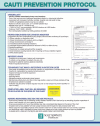Catheter use and infection reduction in plastic surgery
- PMID: 24431946
- PMCID: PMC3891094
- DOI: 10.1177/229255031302100205
Catheter use and infection reduction in plastic surgery
Abstract
Background: Catheter-associated urinary tract infections (CAUTI) are the most common hospital-associated infection and can result in increased health care costs, morbidity and even mortality. In 2009, The Scott & White Memorial Hospital/Texas A&M Health Science Center (Texas, USA) system's CAUTI rate placed it in the upper quartile (ie, highest rate) for the country, necessitating a system-wide change.
Objective: To design and implement a guideline to reduce the incidence of CAUTI.
Methods: A multidisciplinary team was formed and completed both a root cause analysis and a review of the available literature. Consolidating the best evidence, the team formulated a best practice guideline detailing the proper indications for insertion of, improper use of and techniques to minimize infection with catheters. Included as part of this protocol was nursing and patient education, changes in identifying patients with a catheter and automatic termination orders. Three-, six- and 12-month reviews identifying additional opportunities for improvement at the end of 2010 were completed.
Results: In 2009, the hospital's CAUTI rate was 1.46 per 1000 catheter days. In 2011 - the first complete year of the finalized guideline - the hospital's CAUTI rate was 0.52 per 1000 catheter days, ranking the institution in the bottom quartile (ie, lowest rate) for the country. The surgery and plastic surgery subgroup analyses also demonstrated statistically significant reduction in both catheter use and CAUTI.
Conclusion: The incidence of CAUTI was successfully reduced at The Texas A&M Healthcare Center. The guideline, its development and how it applies to plastic surgery patients are discussed.
Historique: L’infection urinaire sur sonde (IUSS) est l’infection nosocomiale la plus fréquente. Elle peut accroître les coûts de santé, la morbidité et même la mortalité. En 2009, le taux d’IUSS du système de The Scott & White Memorial Hospital et du Texas A&M Health Science Center (Texas, États-Unis) la plaçait dans le quartile le plus élevé (c.-à-d. le taux le plus élevé) au pays, ce qui a exigé de modifier l’ensemble du système.
Objectif: Concevoir et mettre en œuvre des lignes directrices pour réduire l’incidence d’IUSS.
Méthodologie: Une équipe multidisciplinaire a été créée et a effectué à la fois une analyse par arbre de défaillances et une analyse bibliographique. Après avoir regroupé les meilleures données probantes, l’équipe a formulé des directives sur les pratiques exemplaires, détaillant les bonnes indications sur l’insertion de la sonde, sa mauvaise utilisation et les techniques pour réduire au minimum les infections sur sonde. L’éducation des infirmières et des patients faisait partie du protocole, de même que les modifications pour déterminer les patients sur sonde et les arrêts automatiques. À la fin de 2010, les chercheurs ont effectué une analyse au bout de trois, six et 12 mois pour établir d’autres possibilités d’amélioration.
Résultats: En 2009, le taux d’IUSS de l’hôpital s’élevait à 1,46 cas sur 1 000 journées sur sonde. En 2011, la première année complète suivant les directives finales, ce taux avait fléchi à 0,52 cas sur 1 000 jours sur sonde, plaçant l’établissement dans le quartile inférieur (c’est-à-dire le taux le plus bas) au pays. Les analyses du sous-groupe de chirurgie et de chirurgie plastique ont également fait foi d’une réduction statistiquement significative de l’utilisation de la sonde et des IUSS.
Conclusion: L’incidence d’IUSS a diminué à The Texas A&M Healthcare Center. Les directives, leur préparation et leur mode d’application à la chirurgie plastique sont exposés.
Keywords: Catheter; Catheter-associated urinary tract infection CAUTI; Hospital-associated infection HAI; Infection; Infection reduction; Risk reduction.
Figures



Similar articles
-
A Multidisciplinary Intervention to Prevent Catheter-Associated Urinary Tract Infections Using Education, Continuum of Care, and Systemwide Buy-In.Ochsner J. 2016 Spring;16(1):96-100. Ochsner J. 2016. PMID: 27046414 Free PMC article.
-
Viewing Prevention of Catheter-Associated Urinary Tract Infection as a System: Using Systems Engineering and Human Factors Engineering in a Quality Improvement Project in an Academic Medical Center.Jt Comm J Qual Patient Saf. 2016;42(10):447-471. doi: 10.1016/s1553-7250(16)42060-x. Jt Comm J Qual Patient Saf. 2016. PMID: 27712603
-
Nursing interventions to reduce the risk of catheter-associated urinary tract infection: part 2: staff education, monitoring, and care techniques.J Wound Ostomy Continence Nurs. 2009 Mar-Apr;36(2):137-54. doi: 10.1097/01.WON.0000347655.56851.04. J Wound Ostomy Continence Nurs. 2009. PMID: 19287262 Review.
-
Prevention and Control of Catheter-Associated Urinary Tract Infection (CAUTI): A Patient Safety and Quality Improvement Project.Cureus. 2024 Oct 22;16(10):e72105. doi: 10.7759/cureus.72105. eCollection 2024 Oct. Cureus. 2024. PMID: 39575052 Free PMC article.
-
Interventions to prevent urinary catheter-associated infections in children and neonates: a systematic review.J Pediatr Urol. 2018 Dec;14(6):556.e1-556.e9. doi: 10.1016/j.jpurol.2018.07.011. Epub 2018 Jul 21. J Pediatr Urol. 2018. PMID: 30126746
References
-
- Guide to the elimination of catheter-associated urinary tract infections (CAUTIs): Developing and applying facility-based prevention interventions in acute and long-term care settings. Greene L, Marx J, Oriola S. Association for Professionals in Infection Control and Epidemiology (APIC), 2008.
-
- Bradley SM, Harleman D, Klee A, et al. Preventing Cather-Associated Urinary Tract Infections (CAUTI) < www.qipa.org/getfile/c831c1b9-d1b6-476f-a6a2-3ec09aa1183c/CAUTI_BPIP-(1)...> (Accessed April 15, 2013).
-
- Haley RW, Hooton TM, Culver DH, et al. Nosocomial infections in U.S. hospitals, 1975–1976: Estimated frequency by selected characteristics of patients. Am J Med. 1981;70:947–59. - PubMed
-
- Warren JW. Catheter-associated urinary tract infections. Infect Dis Clin North Am. 1997;11:609–22. - PubMed
-
- Saint S. Clinical and economic consequences of nosocomial catheter-related bacteriuria. Am J Infect Control. 2000;28:68–75. - PubMed
LinkOut - more resources
Full Text Sources
Other Literature Sources
